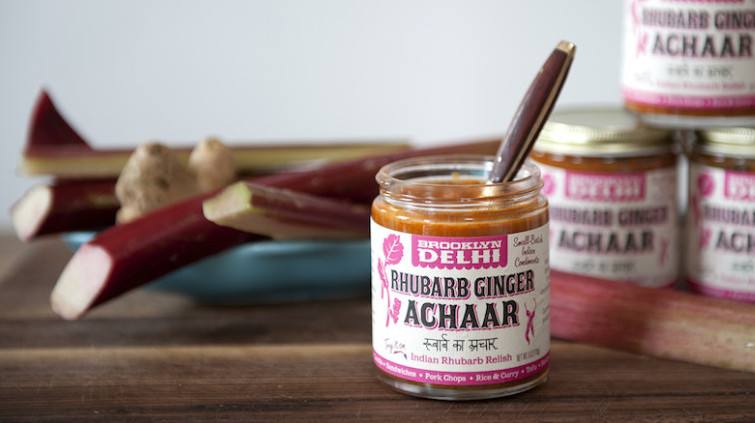Brooklyn Delhi’s richly flavored Indian relishes might seem unorthodox at first — Chitra Agrawal’s achaar replaces unripe mango with Ulster County rhubarb, and swap golf-ball-size Southeast Asian gooseberries for their distant American cousins — but they’re anything but inauthentic.
After all achaar — it’s the Hindi word for pickles, generally applied to chunky, chili-spiked condiments preserved with copious quantities of oil, salt, spice and aromatics — doesn’t just add flavor but helps preserve food, making maximum use of what you have on hand. “It’s like harissa or sriracha,” says Agrawal of the all-purpose condiment, “but it’s made with fruits and vegetables.”
Plus, for Agrawal, who grew up in New Jersey cooking with her Indian-born family, combining past and present is her life’s work: “I want to preserve the Indian cooking techniques,” she says, “but I want to figure out ways to use and promote local farms.”
She’s been doing just that in Brooklyn since 2009, when she started blogging, hosting pop-ups and teaching cooking classes around the theme of preparing Indian vegetarian meals with farm-stand ingredients, all under the moniker the ABCDs of Cooking. (Tagline: “Indian Recipes. Grown in Brooklyn.”)
In fact when she first started selling her achaar two years ago — with help from her husband, Ben Garthus, she makes rhubarb-ginger, gooseberry, roasted garlic and tomato varieties, all meant to be swirled into yogurt, sauces and stews or blended with vegetables and grains — she would change the label with each batch to give credit to the farm that grew the goods.
Custom printing has been put aside as Agrawal has graduated from manning a stand at Smorgasburg to stocking shops like West Elm and Greene Grape Provisions. But she still makes everything by hand, renting time at commercial stoves from St. John’s Bread and Life soup kitchen in Bed-Stuy. She also employs part-time staff through the nonprofit when she needs help topping and tailing 300 pounds of rhubarb or cooking down the same heady mix of black mustard seed, fenugreek, red chile, turmeric and asafetida her grandparents would have employed, albeit with less oil and salt — an adjustment both for health and for flavor.
It might toy with tradition, but it’s winning over those who count the most: Agrawal’s relatives. In fact the cook recalls an aunt who used to make her own tomato achaar with so much oil and salt that you could no longer identify the primary ingredient. Today, says Agrawal, that aunt says, “Now, I want to taste the vegetables.”



